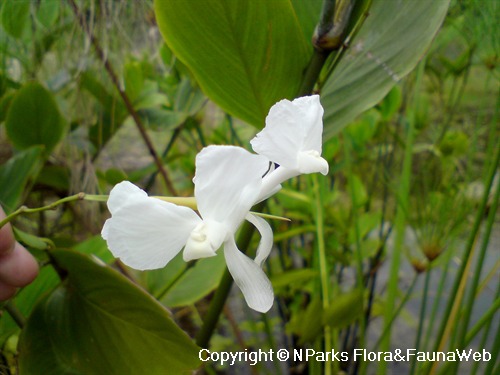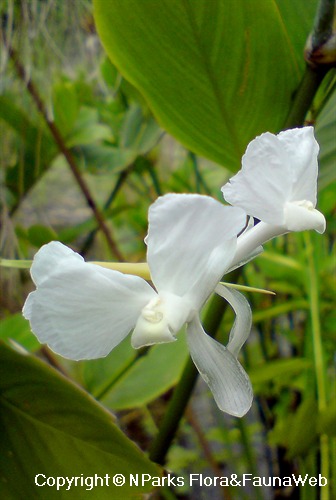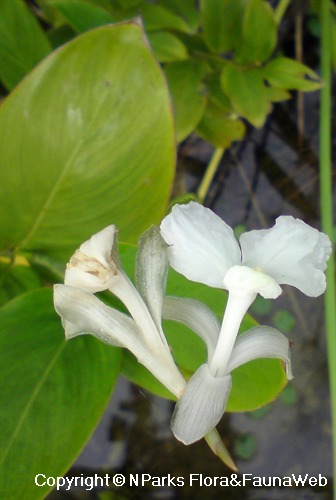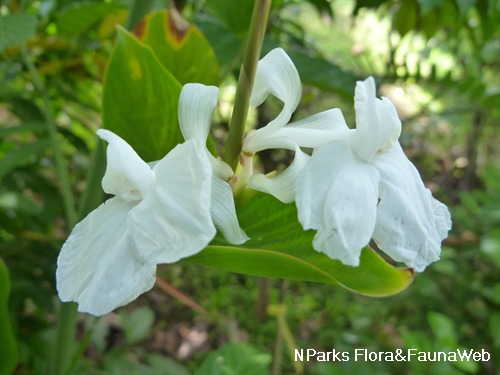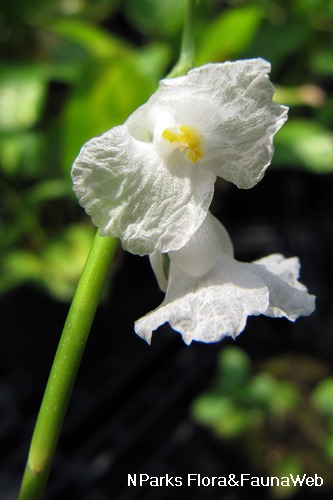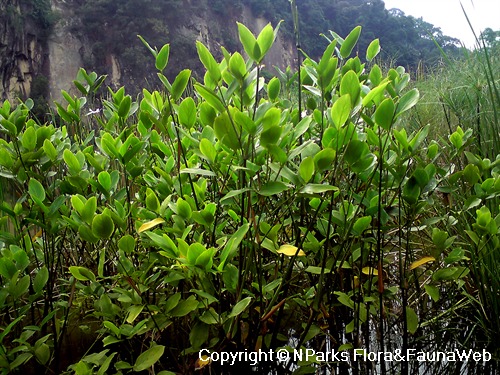
Name
Classifications and Characteristics
| Plant Division | Angiosperms (Flowering Seed Plants) (Monocotyledon) |
|---|---|
| Plant Growth Form | Herbaceous Plant |
| Lifespan (in Singapore) | Perennial |
| Mode of Nutrition | Autotrophic |
| Plant Shape | Irregular |
| Maximum Height | 4 m to 5 m |
Biogeography
| Native Distribution | India (Assam), Bangladesh, East Himalaya, Myanmar, Cambodia, Vietnam, Thailand, Peninsular Malaysia, Borneo, Philippines, |
|---|---|
| Native Habitat | Terrestrial |
| Preferred Climate Zone | Tropical, Sub-Tropical / Monsoonal |
| Local Conservation Status | Non-native (Horticultural / Cultivated Only) |
Description and Ethnobotany
| Growth Form | It is a shrub of about 1.5–2.5 m tall, with hard, upright woody stems that resemble smooth bamboo stems. The stems grow to about 1–2 m tall before branching and producing leaves. |
|---|---|
| Foliage | Its alternate, stalked leaves have leathery leaf blades that are oval, and 10–15 by 6.5 cm. The petioles are short, covered with hair, and 5–8 mm long. The leaf sheaths are 6–11 cm long. |
| Flowers | Its flowers are 4 cm long, faint pinkish-white with a yellowish staminode, borne on a simple or sometimes branched inflorescence. |
| Fruit | Its fruits are 3-lobed, widening upwards from the base, covered with hair, and dehiscent. Each fruit bears 3 arillate seeds that dangle from the fruit wall after the fruit splits open. |
| Habitat | It grows in swamps and along rivers, often forming thickets. |
| Associated Fauna | Its flowers are insect-pollinated. |
| Cultivation | It can be propagated by seed or by division of plants. |
| Etymology | Schumannianthus, commemorating Karl Moritz Schumann (1851–1904), a German botanist from the Botanical Museum, Berlin, who monographed the family Marantaceae and other monocotyledonous families; Latin dichotomus, forked in pairs, repeatedly dividing into two branches, referring to the plant’s leaf arrangement |
Landscaping Features
| Landscaping | It may be suitable as a terrestrial indoor plant or as a marsh plant for the edges of ponds or waterways for its attractive foliage. |
|---|---|
| Desirable Plant Features | Ornamental Fruits, Ornamental Form |
| Landscape Uses | General, Riverine, Pond / Lake / River, Marsh / Bog |
| Thematic Landscaping | Water Garden, Economic Garden, Naturalistic Garden |
Fauna, Pollination and Dispersal
| Pollination Method(s) | Biotic (Fauna) |
|---|
Plant Care and Propagation
| Light Preference | Semi-Shade, Full Sun |
|---|---|
| Water Preference | Moderate Water, Lots of Water |
| Plant Growth Rate | Moderate |
| Rootzone Tolerance | Fertile Loamy Soils, Waterlogged Soils (Drains Site), Easy to Grow |
| Maintenance Requirements | Moderate |
| Propagation Method | Seed, Division |
Foliar
| Foliage Retention | Evergreen |
|---|---|
| Mature Foliage Colour(s) | Green |
| Mature Foliage Texture(s) | Smooth, Glossy / Shiny, Raised / Sunken Veins, Leathery |
| Foliar Type | Simple / Unifoliate |
| Foliar Arrangement Along Stem | Alternate |
| Foliar Attachment to Stem | Petiolate |
| Foliar Shape(s) | Non-Palm Foliage (Ovate, Oval) |
| Foliar Venation | Parallel |
| Foliar Margin | Entire |
Non - Foliar and Storage
| Stem Type & Modification | Acaulescent |
|---|---|
| Root Type | Underground (Fibrous Root) |
| Specialised Storage Organ(s) | Underground (Rhizome) |
Floral (Angiosperm)
| Flower & Plant Sexuality | Bisexual Flowers |
| Flower Colour(s) | White |
|---|---|
| Flower Grouping | Cluster / Inflorescence |
| Flower Symmetry | Bilateral |
| Inflorescence Type | Panicle |
| Flowering Habit | Polycarpic |
Fruit, Seed and Spore
| Mature Fruit Colour(s) | Yellow / Golden |
|---|---|
| Fruit Classification | Simple Fruit |
| Fruit Type | Fleshy Fruit |
Image Repository
Others
| Master ID | 655 |
|---|---|
| Species ID | 1950 |
| Flora Disclaimer | The information in this website has been compiled from reliable sources, such as reference works on medicinal plants. It is not a substitute for medical advice or treatment and NParks does not purport to provide any medical advice. Readers should always consult his/her physician before using or consuming a plant for medicinal purposes. |



